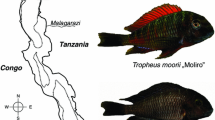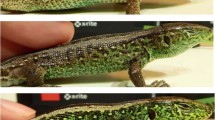Abstract
Female choice on the basis of male traits has been described in an array of taxa but has rarely been demonstrated in reptiles. In the sand lizard (Lacerta agilis), and possibly in other non-territorial reptiles, a male's contribution to a female's fitness is restricted to his genes. In order to choose males of high genetic quality, females have to trade the fitness gain against the costs of active choice. In a Swedish population of sand lizards, long-lived males sired offspring with higher embryonic survival compared to offspring sired by short-lived males. In spite of this female sand lizards did not mate selectively with older and/or larger males. There appeared to be mo reliable cues to male longevity; age-specific male body size was highly variable. Furthermore, estimates of male nuptial coloration did not covary with ectoparasite load and, hence, females cannot use male coloration as a cue to heritable resistance to pathogenic parasite effects. When cues to male genetic quality are poor, or inaccurate, and males make no parental investment, we predict that female choice will be rare. Sand lizard females mating with many partners lay clutches with higher hatching success. Thus, females may obtain “good genes” for their young by multiple mating, thereby avoiding costs associated with mate choice.
Similar content being viewed by others

References
Altmann J (1974) Observational study of behaviour: sampling methods. Behaviour 49:227–267
Andersson M (1994) Sexual selection. Princeton University Press, Princeton
Andersson S (1989) Sexual selection and cues for female choice in leks of Jackson's widowbird Euplectes jacksoni. Behav Ecol Sociobiol 25:403–1110
Andrews R (1985) Mate choice by females of the lizard, Anolis carolinensis. J Herpetol 19:284–289
Bauwens D, Strijbosch H, Stumpel AHP (1983) The lizards Lacerta agilis and L. vivipara as hosts to larvae and nymphs of the tick Ixodes ricinus. Holarct Ecol 6:32–40
Bellis MA, Baker RR (1990). Do females promote sperm competition? Data for humans. Anim Behav 40:997–999
Blackburn D, Evans HE (1986) Why are there no oviparous birds? Am Nat 128:65–190
Burghardt GM, Rand AS (eds) (1982) Iguanas of the world. Noyes, New Jersey
Cooper WE Jr, Vitt LJ (1993) Female mate choice of large male broadheaded skinks. Anim Behav 45:683–693
Cox C, Le Boeuf JB (1977) Female incitation of male competition, a mechanism in sexual selection. Am Nat 111:318–335
Curtsinger JW (1991) Sperm competition and the evolution of multiple mating. Am Nat 138:93–102
Darwin C (1871) The descent of man and selection in relation to sex. Murray, London
Dugan B (1982) The mating behavior of the green Iguana, Iguana iguana. In: Burghardt GM, Rand AS (eds) Iguanas of the world, Noyes, New Jersey, pp 320–340
Hamilton WD, Zuk M (1982) Heritable true fitness and bright birds: a role for parasites? Science 218:384–387
Hemelaar A (1985) An improved method to estimate the number of year rings resorbed in phalanges of Bufo bufo (L.) and its application to populations from different latitudes and altitudes. Amphibia-Reptilia 6:323–341
Hews D (1990) Examining hypotheses generated by field measures of sexual selection on male lizards, Uta palmeri. Evolution 44: 1936–1966
Huey RB, Pianka ER, Schoener TW (eds) (1983) Lizard ecology —studies of a model organism. Harvard University Press, Cambridge
Hunter FM, Petrie M, Otronen M, Birkhead T, Moller AP (1993) Why do females copulate repeatedly with one male? Trends Ecol Evol 8:21–26
Kitzler GZ (1941) Die Paarungsbiologie einiger Eidechsen. Z Tierpsychol 4:355–402
Madsen T, Shine R (1992) Determinants of reproductive success in female adders, Vipera berus. Oecologia 92:40–47
Madsen T, Shine R, Loman J, Håkansson T (1992) Why do females copulate so frequently? Nature 355:440–441
Magnhagen C (1991) Predation risk as a cost of reproduction. Trends Ecol Evol 6:183–186
Olsson M (1986) Spatial distribution and home range size in the Swedish sand lizard, Lacerta agilis. In: Z. Rócek (ed) Studies in herpetology. Charle's University, Prague, pp. 597–600
Olsson M (1992a) Sexual selection and reproductive strategies in the sand lizard. PhD thesis, University of Göteborg
Olsson M (1992b) Contest success in relation to size and residency in the sand lizard, Lacerta agilis. Anim Behav 44:386–388
Olsson M (1993a) Male choice of large females and assortative mating for body size in the sand lizard. Behav Ecol Sociobiol 32: 327–341
Olsson M (1993b) Nuptial coloration and predation risk in model sand lizards, Lacerta agilis. Anim Behav 46:410–412
Olsson M (1993c) Contest success and mate guarding in male sand lizards, Lacerta agilis. Anim Behav 46:408–409
Olsson M (1994a) Nuptial coloration in the male sand lizard, Lacerta agilis — an intrasexually selected cue to fighting ability. Anim Behav 48:607–613
Olsson M (1994b) Why are sand lizard males (Lacerta agilis) not equally green? Behav Ecol Sociobiol 35:169–173
Olsson M (1994c) Rival recognition affects male contest behavior in sand lizard males (Lacerta agilis) Behav Ecol Sociobiol 35:249–252
Olsson M, Gullberg A, Tegelström H, (1994a) Sperm competition in the sand lizard. Anim Behav 48:193–200
Olsson M, Gullberg A, Tegelström H, Madsen T and Shine R (1994b) ‘Promiscuous’ matings enhance maternal fitness in lizards (scientific correspondence). Nature 369:528
Parker G (1983) Mate quality and mating decisions. In: Bateson P. (ed) Mate choice, Cambridge University Press, Cambridge, pp 141–164
Parker G (1992) Snakes and female sexuality. Nature 355:395–396
Ruby DE (1981) Phenotypic correlates of male reproductive success in the lizard, Sceloporus jarrovi. In: Alexander RD, Tinkle DW, (eds) Natural selection and social behavior: recent research and new theory, Chiron Press, New York, pp 96–107
SAS (1988) Statistical analysis system (PC version). SAS Institute, Cary
Shine R (1988) Parental care in reptiles. In: Gans C, Huey RB (eds) Biology of the reptilia, vol 16. Liss, New York, pp 275–330
Sigmund W (1983) Female preference for Anolis carolinensis males as a function of dewlap color and background coloration. J Herpetol 17:137–143
Smith RL (1984) Sperm competition and the evolution of animal mating systems. Academic Press, Orlando
Stamps J (1983) Sexual selection, sexual dimorphism, and territoriality. In: Huey RB, Pianka ER, Schoener TW, (eds) Lizard ecology — studies of a model organism. Harvard University Press, Cambridge, pp 109–134
Svahn K (1974) Incidence of blood parasites of the genus Karyolysus (Coccidia) in Scandinavian lizards. Oikos 25:43–53
Wildt DE, Bush M, Goodrowe KL, Packer C, Pusey AE, Brown JL, Joslin P, O'Brien SJ (1987) Reproductive and genetic consequences of founding isolated lion populations. Nature 329:328–331
Yablokov AV, Baranov SA, Rozanov SA (1980) Population structure, geographic variation, and microphylogenesis of the sand lizard (Lacerta agilis). Evol Biol 12:91–127
Zucker N (1988) A method for rapid and precise documentation of lizard coloration. Herpetol Rev 19:13–16
Author information
Authors and Affiliations
Rights and permissions
About this article
Cite this article
Olsson, M., Madsen, T. Female choice on male quantitative traits in lizards — why is it so rare?. Behav Ecol Sociobiol 36, 179–184 (1995). https://doi.org/10.1007/BF00177794
Received:
Accepted:
Issue Date:
DOI: https://doi.org/10.1007/BF00177794



